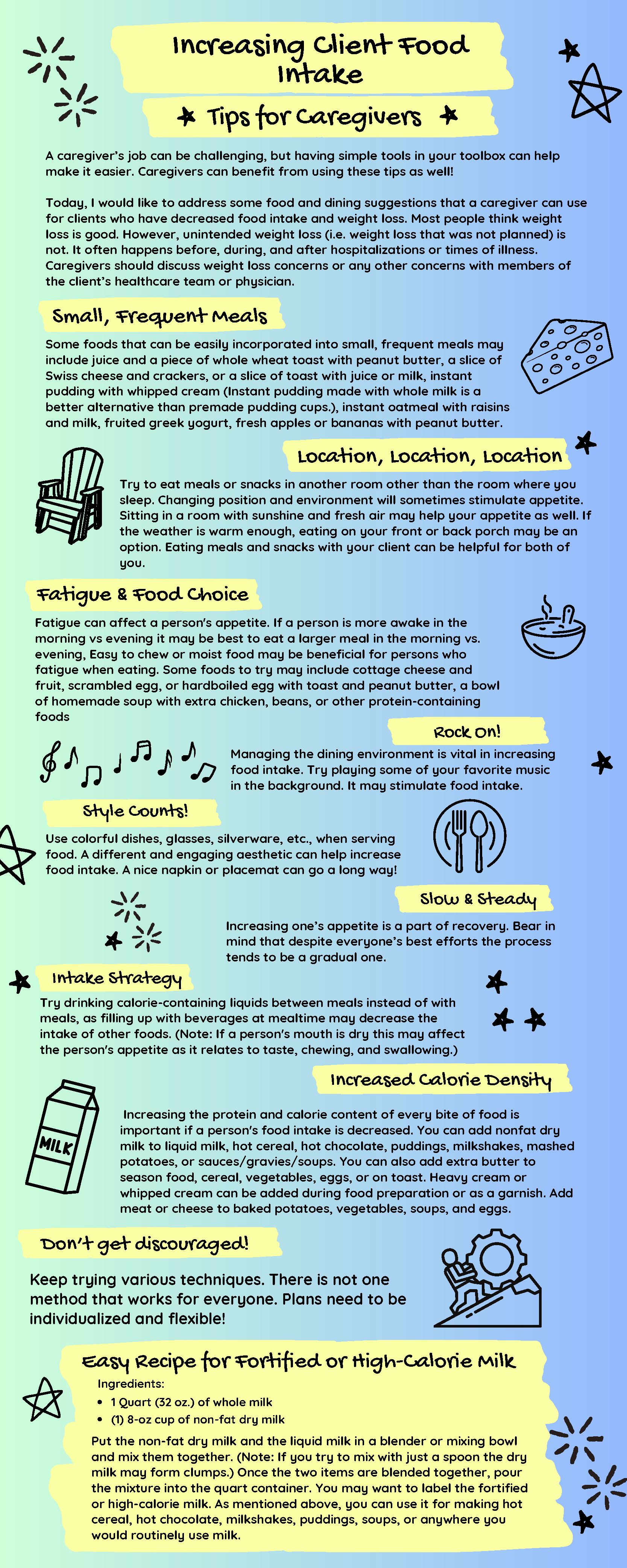A caregiver’s job can be a challenge. Having simple things in your toolbox can make the job easier. Remember caregiver care is important as well. Some of these simple things can be used for you as well.
Today, I would like to address some food and dining suggestions that a caregiver can use when the person has decreased food intake and weight loss. Most people think that weight loss is good. However, unintended weight loss is not good. Unintended weight loss is weight loss that was not planned. It often happens, before, during, and after hospitalizations or during times of illness. The caregiver should discuss the concern of weight loss with members of the health care team or physician.
The tips are:
1. Small frequent meals. Some food examples for small frequent meals may include juice and a piece of whole wheat toast with peanut butter, a slice of Swiss cheese and crackers, or a slice of toast with juice or milk, instant pudding with whipped cream ( instant pudding made with whole milk is a better alternative than premade pudding cups), instant oatmeal with raisins and milk, fruited greek yogurt, fresh apples or bananas with peanut butter.
2. Try to eat meals or snacks in another room other than the room where you sleep. Changing position and environment sometimes will stimulate appetite, Sitting in a room with sunshine and fresh air will sometimes help with appetite as well. It is warmer weather eating on the front or back porch may be an option.
3. Fatigue can affect a person’s appetite. If a person is more awake in the morning vs evening it may be best to eat a larger meal in the morning vs. evening, Easy to chew or moist food may be beneficial for persons who fatigue when eating. Some foods to try may include cottage cheese and fruit, scrambled egg, or hardboiled egg with toast and peanut butter, a bowl of homemade soup with extra chicken, beans, or other protein-containing foods.
4. Serve food on nice highly-colored dishes or beverages in nice glasses or cups. Having the food appearance will often help increase food intake.
5. The dining environment with favorite music playing in the background may stimulate food intake. The dining environment is vital in increasing food intake.
6. The process and change in food intake despite everyone’s best efforts may be a slow gradual process. The increase in appetite is part of the recovery process.
7. If a person’s mouth is dry this may affect the person’s appetite as it relates to taste. and chewing/swallowing. Drinking calorie-containing liquids between meals vs with meals may be beneficial. Filling up with beverages at mealtime may decrease the intake of other foods.
Below I have included some ideas of ways to increase the caloric density of food. Increasing the protein and calorie content of every bite of food is important if a person’s food intake is decreased.
Some foods that can be used to increase the calorie or protein content of food include: adding nonfat dry milk to liquid milk, hot cereal, hot chocolate, puddings, milkshakes, mashed potatoes, or sauces/gravies/soups, adding extra butter to season food, cereal, vegetables, add to eggs, or on toast, add heavy cream or whipped cream in food preparation or as a garnish, or add meat or cheese to food: baked potatoes, vegetables, soups, eggs, Do not get discouraged if these method do not work. Keep trying various techniques.
These tips do not require spending extra money. The tips are meant to be simple and easy. A nice napkin or placemat may help someone eat more.
There is not one or only one method that works for everyone. The plan needs to be individualized and flexible you need to consult various members of your healthcare team or physician if you have any questions.
The caregiver needs to eat healthy as well. Eating meals and snacks with a person you are caring for is sometimes helpful for both of you. A change in environment for the caregiver may make eating easier for you as well.
An easy recipe a caregiver can use for making fortified or high-calorie milk is :
- A quart or 32 ounces of whole milk
- 1 8-ounce cup of non-fat dry milk
- Pour both of these items into a blender or a mixing bowl
Blend the non-fat dry milk into the liquid milk . If you try to mix with just a spoon the dry milk may form clumps. Once the two items are blended together pour back into the quart container. You may want to label the fortified or high-calorie milk. As mentioned above you can use it for making hot cereal, hot chocolate, milk shakes, puddings, soups, or anywhere you would routinely use milk.


